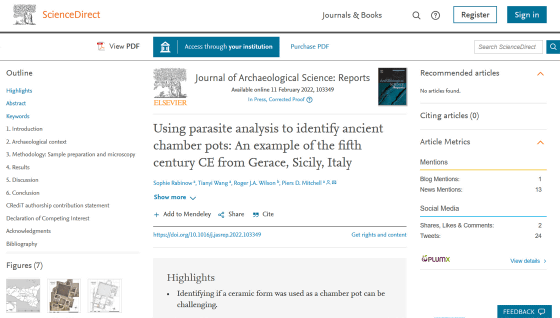It turns out that the 1500-year-old container excavated from the ruins was a 'Roman toilet'

by RJA Wilson
The container excavated from the villa used by the Romans 1500 years ago was found to be a 'toilet 1500 years ago' from the analysis of the contents. Evidence that it was used as a toilet was the 'parasite egg' contained in the solidified sediments.
Using parasite analysis to identify ancient chamber pots: An example of the fifth century CE from Gerace, Sicily, Italy --ScienceDirect

Identifying the portable toilets of the ancie | Eurek Alert!
https://www.eurekalert.org/news-releases/942611
Archaeologists Figured Out How to Tell if One of These Roman Pots Was Used For Poop
https://www.sciencealert.com/conical-storage-pots-found-near-roman-latrines-held-just-what-you-d-think
1,500-year-old Roman'flower pot' was actually a port-o-potty | Live Science
https://www.livescience.com/roman-empire-port-o-potty
At the site named 'Villa of Gerace' on Sicily , Italy, the existence of facilities such as baths, storages and kilns used in the 4th and 5th centuries has been confirmed. Relics other than the facility have also been excavated from this site, one of which is a 'container' with a height of about 32 cm and a diameter of about 34 cm. The image below was taken from directly above the ruins, and the container was excavated at the location indicated by the red circle.

by RJA Wilson
At the time of discovery, the container was buried in the soil and was in a cracked state.

by RJA Wilson
The photo below is a restored container that was excavated. Roger Wilson, a professor of archeology at the University of British Columbia, Canada, said: 'It is recognized that this type of conical vessel was fairly widespread in the Roman Empire, and often because there is no other evidence. It is called a 'storage pot'. It was pointed out that it may have been used as an indoor toilet bowl because it was found in large numbers in and around public toilets, but it has not been confirmed so far. ' It states.

by RJA Wilson
When the research team analyzed the solidified residue inside the container under a microscope, an egg of a parasite called ' whipworm ' was discovered. Since whipworm is a type of parasite that lives in the human large intestine, this container contains 'human stool'. In other words, this container was used as a Roman 'toilet'.
It is possible that the research team used this container as a toilet instead of leaving the bath facility and going to the villa's toilet because it seems that the bath facility did not have a toilet. Pointed out that there is. Also, the research team thinks that the container was not used as a toilet by itself because of the size of the container, but the container was placed under a wooden chair with a hole to make it a toilet.
The solid matter analyzed this time is a solidified mineral contained in feces and urine after being repeatedly used as a toilet, and the egg of whipworm is mixed with the excrement of a person infected with whipworm. It is believed to have been deposited in the form. 'The parasite eggs were found to be trapped in a layer of minerals formed on the surface of the container and preserved for centuries,' said Sophie Rabinou of the University of Cambridge, the lead author of the paper. '. 'It's very exciting to find eggs of these parasites 1500 years after deposition,' said Tierney Wang of the University of Cambridge, who participated in the microscopic analysis.
It is unclear whether all similar containers excavated at the remains of the Roman Empire were used for toilets, and some of the similar containers were used for storing grains and water, and were used as urns. It is also suggested that there may be. Pears Mitchell, a parasite expert at the University of Cambridge, said, 'It has been confirmed that there is such a mineralized solid substance at the bottom of the Roman container displayed in the museum. You can use to find out if it was used as a toilet. '
Related Posts:
in Science, Posted by log1h_ik







